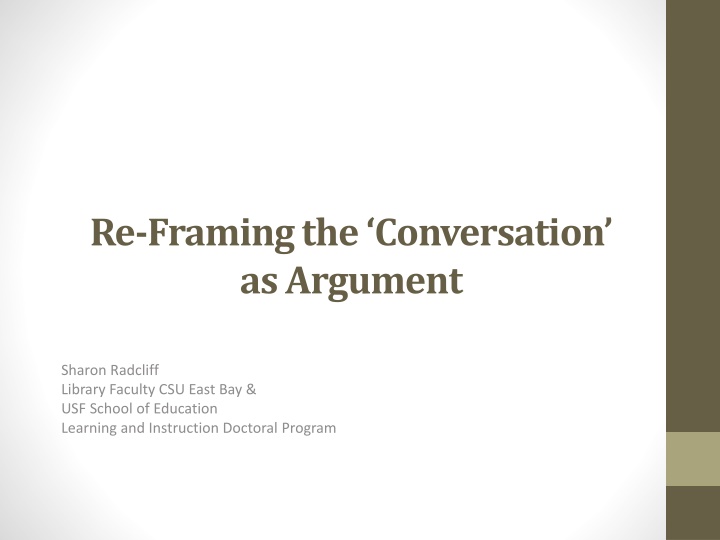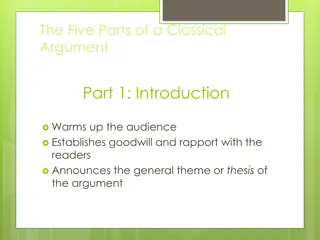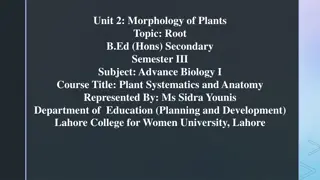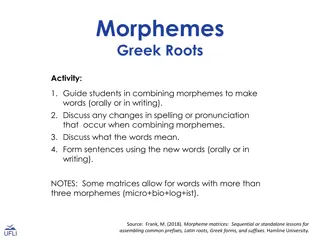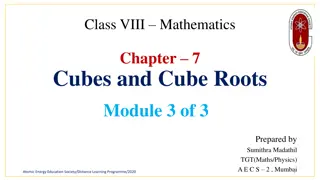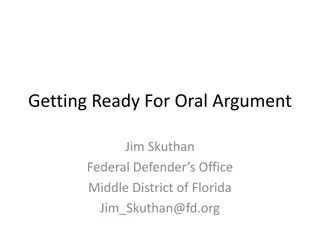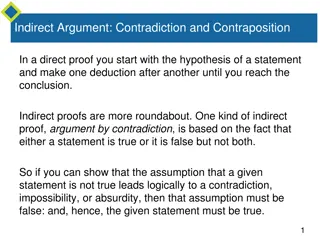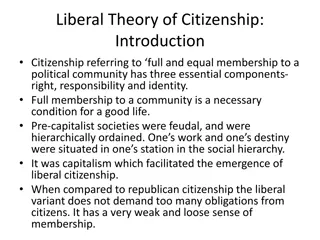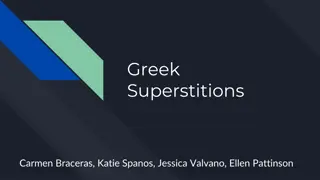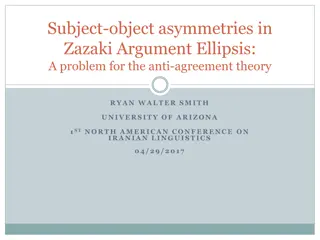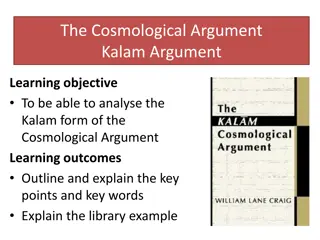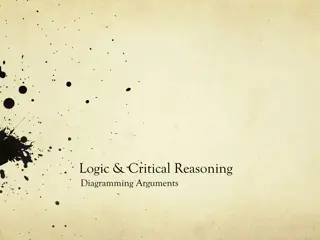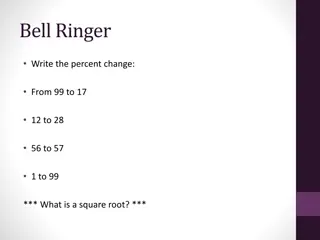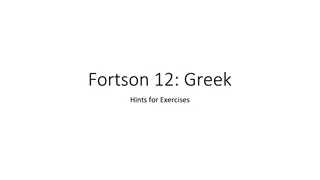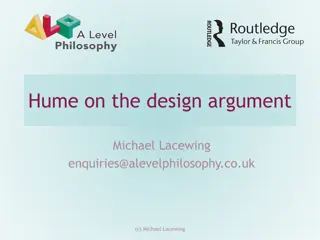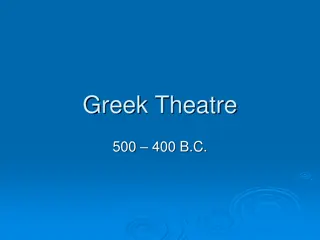Argument Theory and Its Evolution: Unveiling the Greek Roots
The paper delves into the history and evolution of argument theory, exploring its roots in ancient Greece and the contributions of Aristotle. It highlights the importance of argument literacy in education and examines how argumentation is currently taught. By examining the three major branches of argument according to Aristotle, the paper sheds light on the significance of developing critical thinking skills through the art of persuasion and systematic dialogue.
Download Presentation

Please find below an Image/Link to download the presentation.
The content on the website is provided AS IS for your information and personal use only. It may not be sold, licensed, or shared on other websites without obtaining consent from the author.If you encounter any issues during the download, it is possible that the publisher has removed the file from their server.
You are allowed to download the files provided on this website for personal or commercial use, subject to the condition that they are used lawfully. All files are the property of their respective owners.
The content on the website is provided AS IS for your information and personal use only. It may not be sold, licensed, or shared on other websites without obtaining consent from the author.
E N D
Presentation Transcript
Re-Framing the Conversation as Argument Sharon Radcliff Library Faculty CSU East Bay & USF School of Education Learning and Instruction Doctoral Program
Abstract: The ability to understand more than one point of view, critique and create arguments is a widely accepted learning objective for any student engaged in a liberal arts education. As Gerald Graff states: This argument literacy, the ability to listen, summarize, and respond, is rightly viewed as central to being educated. (Graff 2003 p.3). But how does this learning take place? Often times responsibility for it is handed over (at least the beginnings of it) to English Composition and/or critical thinking faculty teaching stand alone courses or courses that are part of a first-year learning community. This paper explores the history of argument theory, its relationship to the Framework for information literacy and how argument is currently taught by looking at theoretical and empirical studies. Graff, G. (2003) . Clueless in the academe: How schooling obscures the life of the mind. New Haven: Yale University Press.
Working Definition of Argument: Argumentation is a verbal, social, and rational activity aimed at convincing a reasonable critic of the acceptability of a standpoint by putting forward a constellation of propositions justifying or refuting the proposition expressed in the standpoint. (Van Eemeren & Grootendorst, 2004, 1) van Emeren, F., and Grootendorst, R. (2004). A systematic theory of argumentation: The Pragma-dialectic approach. +Cambridge: Cambridge University Press.
Greek Roots of Argument Theory Sophists, the first to question the certainties of traditional beliefs about the gods and physical world, taught various types of argument skills mostly for debating purposes amongst the wealthier, politically inclined citizens; the development of argument theory as we know it today is largely attributed to Aristotle.
Aristotles Three Major Branches of Argument: Three major branches:(van Emeren & Grootendorst 2004) Syllogistic Logic: Analytica : Includes inductive and deductive logic; (premises evidently true) Dialectic: Dialectica systematic dialogue between moves for and against a particular hypothesis; (premises are generally accepted as true) Rhetoric: Rhetorica : art of persuading a particular audience; (premises need only be plausible) van Emeren, F., and Grootendorst, R. (2004). A systematic theory of argumentation: The Pragma-dialectic approach. Cambridge: Cambridge University Press.
The three types of Aristotelian arguments and their characteristics (van Eemeren, Grootendorst, Henkemans1996) van Eemeren, Grootendorst, Henkemans(1996). Fundamentals of argument theory: A handbook of historical backgrounds and contemporary developments. Mahwah, New Jersey: Lawrence ErblaumAssociates.
Syllogistic Logic--Deductive: Aristotelian Argument: Enthymeme Major Premise: All humans are mortal. Minor Premise: All Greeks are human. Conclusion: All Greeks are mortal.
Visualization of an enthymeme: The category, humans, contains the category, Greeks. Humans have the characteristic of mortality; therefore so do Greeks. All Greeks = Humans Humans = Mortal
Other forms: All predators hunt Some pets are predators Some pets hunt No work is fun Sewing is work Sewing is not fun Some caterpillars become butterflies No eels become butterflies Some caterpillars are not eels
Deductive Arguments are: Valid or invalid: if the form is correct if it is valid Sound or unsound: the claims leading to the conclusion are true Modern types of deductive arguments: From mathematics From definition Categorical syllogism Hypothetical syllogism If it rains he will use an umbrella; it is raining; therefore he is using an umbrella Disjunctive syllogism We will go to the park or to the museum; the museum is closed; therefore we will go to the park.
Deductive arguments All plants grow well in swamps Roses are plants Therefore roses grow well in swamps Valid but unsound. All potatoes are round All plates are square Therefore all potatoes are plates Invalid and unsound
Syllogistic Logic -- Inductive Example One: Every time Jane heats a pot of water on the stove it boils. When Jane heats this pot of water on the stove, it will boil. Example Two: Every time Fred opens a can of tuna, the cat comes running in. Fred is opening a can of tuna, so the cat will come running in. Example three: Every time Jack goes out in the rain, he gets wet. When he goes out in the rain this time, he will get wet.
Inductive arguments are: Strong/weak ( more than 50% likelihood that the conclusion is true = strong) Cogent/uncogent (cogency depends on the truth of the claims leading to the conclusion) Examples: Prediction Causal inference From examples to generalization Arguments form analogy Argument from signs Argument from authority
Examples of strong/weak & cogent and uncogent arguments Every time I see heavy black clouds it rains. I see those clouds now; therefore it will rain. Strong and cogent! Every person I have met this morning has had brown eyes. Everyone in the world has brown eyes. The next person I meet will have brown eyes. Weak and uncogent!
Your turn: Work with a partner on Handout one Review: Logical syllogism may be deductive (valid/sound) or inductive(strong/cogent) : Deductive example: (valid and sound) Major claim: All fish have gills. Minor claim: All tunas are fish. Conclusion: All tunas have gills. Inductive Example: (strong/cogent) The sun rises every morning. The sun will rise this morning.
Dialectical Argument Systematic dialogue where moves for and against a particular hypothesis or thesis are made. (van Eemeren, Grootendurst 2004) Originally it took the form --now known as reductio ad absurdum of an indirect proof where a counter claim is disproved by deriving an untrue claim from it. In the Topics, Aristotle, describes how to attack and defend against an attack and how to get concessions form an opponent That will lead to a contradiction that will cause a weakening of their original thesis. The goal of the dialectic in the time of Aristotle was to force a speaker into a contradiction and therefore lose the debate or discussion.
Example of moves or loci) in a Dialectical Argument (van Eemeren, Grootendurst 2004)
The dialectic moves Defender: Health and gymnastics are of equal value. Attacker: Is something valuable in itself more valuable than something valued only to attain something else? Defender: Yes. Attacker: Is health is valuable in itself? Defender: Yes Attacker: Is gymnastics primarily valuable to attain fitness? Defender: agreed --- Here is the concession Attacker: Then you must also agree that health is more valuable than gymnastics!
Rhetoric Aristotle to Cicero- Modern Times Rhetoric was the third major branch of argument handed down from Ancient Greece and developed by Aristotle and the by Cicero and many others. Rhetoric -- then as now-- is considered to be the art of persuading a particular audience of the speaker s point of view. (Or in the case now a universal audience may sometimes be used ) Aristotle saw rhetoric as composed of: Extrinsic sources such as laws, documents, facts at hand, etc.. and intrinsic abilities of the speaker: Ethos, Pathos, Logos Fallacies: avoided by the speaker, pointed out by a critical audience
Ethos, Pathos, Logos Ethos: The character and reputation of the speaker Logos: the logical quality of the arguments (recall deductive and inductive reasoning) Pathos: the emotional quality or impact of the arguments
Fallacies: The study of fallacies begun by Aristotle continues; some common ones are: Ad Hominem False Dilemma Non Sequitur Straw Man Red Herring Dubious Cause
The New Rhetoric of Chaim Perelman and Lucie Olbrechts-Tyteca (1950 s) These two Belgian professors of philosophy sought to join the dialectic with rhetoric by forming a descriptive phenomenological theory of argumentation which incorporated the dialectic and the rhetorical, so in other words it examined argument as both dialogue and a vehicle for persuasive thought, understanding that both logical reasoning and value judgment paly a role in human discourse. They place a strong emphasis on presenting an argument as if it was a dialogue with an audience, incorporating an understanding of what that audience s value, background knowledge and beliefs most likely are.
Components of the New Rhetoric: Premises are a mix of truth and preference The real: facts Truths Presumptions The preferable: Values (individualistic) Value hierarchies (group world views) Loci (preferences)
Rhetoric and Composition or Academic Writing At the same time that argumentation theory was developing so too was composition theory. Many saw the need to incorporate argumentation theory into the study of composition. To name a few major composition theorists who have presented views on this: Christopher Tindale: (2004) Rhetorical Argumentation Gerald Graff & Cathy Birkenstein (2006) They Say, I say: The Moves that Matter in Academic Writing Andrea Lundsforth, John Ruszkiewicz, Keith Walters: (2000) Everything s an Argument
The Setting for Teaching Argument: Teaching the Recursive Process of Writing the Argument Research Paper From Cappella University s Writing Process Manual
The Problem: Some problems that have been identified in the literature with students argument writing process are: Avoiding myside bias Incorporating more than one perspective into an argument Provide counter-arguments and rebuttals to strengthen the argument Identify personal bias in their own view of a topic Reading arguments critically Understand the argument structure of articles read on a topic Understanding the how the authors perspective and purpose affect the kind of evidence and claims presented. Evaluating Sources Evaluating sources critically for inclusion as backing for an argument Evaluating the quality of a source s argument and evidence presented. Synthesizing Material Synthesizing material from sources to build a balanced argument.
Toulmins Model: Leong, P. A. (2013) Thinking Critically: A look at students critiques of a research article. Higher Education Research & Development. 32(4).575-589.
Handout two: Toulmin Sample argument: Claim: Qualifer: Exception/counter-argument Data/evidence Warrant (reason to connect evidence and claim) Backing (beliefs that justify warrant, etc..) Rebuttal: argument back against counter-argument or qualifier
Traditional ways of evaluating: Check for Timeliness and Relevance and Quality Is the article on your topic? Does it provide background on your topic or information useful to building your own argument? Is the article recent enough to be useful to you? How recent it needs to be depends on the subject matter and scope of your topic Is it Scholarly? Was it published by a university press? Peer reviewed?
Is it Scholarly? Things we tell students: You can limit to peer reviewed or scholarly In most databases. Peer-reviewed means reviewed by scholars in the field. Another way to check is to look at the name of the source: review or journal often appears; articles tend to cite studies and have longer bibliographies and are written by academics.
Using the Framework Research as Inquiry Scholarship as Conversation Authority is Constructed and Contextual (ACRL, 2016, http://www.ala.org/acrl/standards/ilframework)
Scholarship is a Conversation: Also Do a Content Analysis of the Argument (Radcliff & Wong 2014) Once you have established relevancy, timeliness and scholarliness, read through the article s abstract. Look for the following elements: Claim (factual, value, policy usually policy claims are a mix of value based ideas and facts) Evidence (data, statistics, empirical studies, anecdotal) Reasoning: (Warrant): Logical link between evidence and claim/hidden assumptions Alternative viewpoint or counter argument (Toulmin s Qualifier) Rebuttal (argument against the opposing view; will have its own claim, evidence, etc..) Backing: beliefs behind the validity of the evidence
Example Argument from an Article Abstract: Children should not be exposed to TV violence because it will cause them to behave more aggressively. A study showed that children who watched more violent shows on television were more likely to be told to go to the principal s office. Going to the principals office is often caused by showing aggressive behavior. Children who watched more violent shows also spent more time overall watching TV, and less time with peers, doing homework or participating in family activities; these could be contributing factors to the aggressive behavior. Although there may be other factors involved, the strong correlation the study showed between violent TV shows (not just any TV shows) indicates that it is the violence on these TV shows is a likely cause of the students aggressive behavior.
Claim Find the main claim of the article by reading the abstract (many scholarly articles include an abstract or summary of the article) or the introduction. Ask: What is the article trying to prove? Example: Television violence causes aggression in children What kind of claim is it ? Claims are usually factual, related to values, or to policies. (This determines what kind of evidence and reasoning to expect.)
Evidence Read the article in detail: What kind of evidence is being used to back up the claim? For example does the article include: facts, data from studies, anecdotes (stories), expert opinions, interviews, or other types of evidence? Example: Studies show a correlation between hours watching violent TV and visits to the principal s office.
Reasoning & Assumptions What logic or reason links the evidence to the claim: Example: Claim: Watching violent TV increases aggressiveness in children Evidence: Studies show a correlation between hours watching violent TV and visits to the principal s office. Reasoning: Visiting the principal s office is often caused by a child s aggressive behavior. (Look for unstated reasons and hidden and possibly biased assumptions.)
Alternative or Opposing Viewpoints Another way to view the evidence or presentation of a different claim that opposes yours. Example: Viewing more violent television is caused by lack of opportunities for family and peer interactions which is the real cause of the increase in aggression in the children who view more TV. Rebuttal: This argument can be rebutted or refuted by finding evidence that the television is really affecting behavior.
Credibility: Traditional Credibility: Primarily relates to the character and credibility of the author. This can be difficult to establish but one strategy is to find out what the credentials of the author is and what else the author has written on the topic. Some information about the author may be found in Biography related databases, or in Lexis Nexis or other biographical sources.
More on Credibility: Use Ethos, Pathos, Logos What is the authors reputation? Look at the language used by the author. How emotional is the language? Is it slanted positively or negatively? Is the logic clear? Who is the intended audience? What is the author s purpose? What do you know about how it fits into what you have read on the topic? Does it seem to have a particular bias?
Credibility: Authority is Constructed and Contextual Think about backing: what set of values, beliefs does this argument rest on Why is this topic important to the authors/intended audience? What is the context in which this article/argument is situated (is there an ongoing debate, if so who are the various factions? ) Framework for Information literacy: what kind of conversation is it? What voices are privileged? And how? For example when backing is considered in an argument, it may become clear that an argument rests on accepting cultural values that have been elevated through a social or political power structure.
Reliability: Traditional Reliability relates mainly to the source of the article. What kind of publication is it in? (In this case it should be scholarly; but at other times it could be trade read by professionals in the field, or popular read by a general audience. Even scholarly publication may differ in quality. You can find out about the quality of a publication by using Ulrich s Periodical Directory.
Reliability: Contextualized and Framed as Argument Who is privileged in the debate? Who gets to publish Why are some publishers higher ranked than others?
Bringing the dialectic back Toulmin s ideas (Toulmin 2003) have been integrated into countless textbooks for argument and critical thinking courses courses since the 1950 s into the present day. Most see the Toulmin structural approach to argument as primarily rooted in the rhetorical tradition of argument with an emphasis on persuasion; meanwhile argumentation theory has continued to evolve and bring the dialectic branch of argument back in to the foreground. First came the New Rhetoric of Perelman and Olbrechts- Tyteca; followed by the development of Pragma-Dialectics by van Eemeren and Grootendorst.
Pragma-Dialectics (van Eemeren, Grouttendorst This theory assumes that argumentation is a representation of an exchange of ideas between two parties with differing viewpoints on a topic, even when this exchange is represented as a monologue as in a typical argument essay. It posits four stages of discourse: Confrontation Opening Argumentation Concluding The goal is more one of integration than winning (as opposed to classical rhetoric)
Douglas Walton: Walton (2008) also works in the area of dialectic theory of argumentation, specifically classifying various kinds of dialogues that form arguments, such as the argument from expert witness. He is concerned with probing the relative strengths of arguments via the use of questions: For example suppose we look at the argument: North American Children are not healthy
Graphic Representation of a Complex Argument Patterson, F. (2011) Visualising the Critical thinking process. Issues. 95 (June) 36-41
Studies show: Students who are taught argument schema using the Toulmin model construct better arguments with more opposing points and rebuttals. Students who are also taught to generate critical thinking questions based on argument schema create even better arguments. Engaging students in dialogue about arguments and alternative viewpoints create opportunities to avoid myside or confirmation bias. Nussbaum, E. M, & Schraw, G. (2007). Promoting argument-counterargument integration in students writing. The Journal of Experimental Education. 76 (1). 59-92. Song, Y. & Ferretti, R. (2012) Teaching critical questions about argumentation through the revising process: effects of strategy instruction on college students argumentative essays. Reading and Writing Quarterly (26) 67-90. DOI:10.1007/ s11145-012-9381-8. Wolfe, C. (2012) Individual differences in the myside bias in reasoning and written argumentation. Written Communication. 29. 477-501. DOI: 10.1177/0741088312457909
Example of Critical Thinking Questions Combined with Argument Schema (Nussbaum & Schraw 2007)
